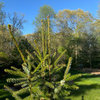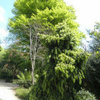pinus strobiformins, reflexa or ayacahuite brachyptera??
ospreynn
18 years ago
More Discussions
I am confused with all the information I found about the south western border pine. I tried to figure this out, but even books seem to contradict themselves. I want to get a tree from forest farm but it says pinus strobiformis (reflexa), I wonder what it will be. I am interested in pinus ayacahuite brachyptera because of its cones. Will this be the same. I will appreciate any help making clear the differences between these species.
osprey




pineresin
ospreynnOriginal Author
Related Professionals
Harvey Landscape Architects & Landscape Designers · Jackson Landscape Contractors · Edmond Landscape Contractors · Brookline Landscape Contractors · Elkridge Landscape Contractors · Ellicott City Landscape Contractors · Galt Landscape Contractors · Las Vegas Landscape Contractors · Methuen Landscape Contractors · Muttontown Landscape Contractors · Nashua Landscape Contractors · Peachtree City Landscape Contractors · Rockland Landscape Contractors · View Park-Windsor Hills Landscape Contractors · Wilsonville Landscape Contractorshappyhoe
ospreynnOriginal Author
pineresin
nothotsuga
kman04
flattie